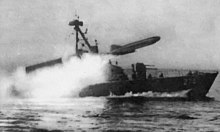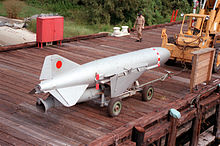SS-N-2 Styx
| SS-N-2 Styx | |
|---|---|
| General Information | |
| Type | Anti-ship guided missile |
| Manufacturer | OKB-155 ( Mikoyan-Gurevich ) |
| development | 1955 |
| Technical specifications | |
| length | 6.49 m |
| diameter | 780 mm |
| Combat weight | 2,500 kg |
| span | 2,400 mm |
| Drive First stage Second stage |
2 solid booster rocket motor with hypergolic two-component liquid fuel |
| speed | 300 m / s |
| Range | 85 km |
| Furnishing | |
| Target location | Inertial navigation platform plus data updates during the cruise flight plus active radar target search or infrared guidance |
| Warhead | 513 kg, armor piercing |
| Weapon platforms | Ships |
| Lists on the subject | |
The SS-N-2 Styx ( NATO code ) is a ship-based anti-ship guided missile that was developed in the Soviet Union . The GRAU index is 4K40 and the system index of the Russian armed forces is P-15 Termit / P-20 Rubesch . The missile design from the 1950s belongs to the first generation of Soviet anti-ship guided missiles.
development
The SS-N-2 Styx was designed as an anti-ship guided missile for use on small and medium-sized surface vessels. Development of the OKB-155 began in early 1955. The first test launch of a test boat of the Project 183e type took place on October 16, 1957. In 1958, the SS-N-2 was officially taken over into the Soviet Navy . First the Komar and Osa class fast attack boats were equipped with the guided weapon.
After that, the SS-N-2 was exported to various friendly states in the Eastern Bloc , Asia and the Middle East.
In 1959 the plans for the SS-N-2 were sold to China , where license production began in 1974. In China, further copies of the SS-N-2 were developed as land-based anti-ship weapons under the NATO designation CSS-C-2 Silkworm and CSS-C-3 Seersucker .
Further licensed productions, some with Chinese help, took place in North Korea and Iran .
technology
The basic version P-15 had fixed wings and was fired from a container from a launch rail. The guided missile was started by a solid fuel booster and then propelled by a rocket engine for liquid fuel. In addition to the actual seeker head, the guided missile had a simple inertial navigation system and a barometric altimeter. This was replaced by a radar altimeter in later models. The guided missile flew at a height of 100 to 200 meters. For the final approach, the target was recorded with an active radar; the guided missile then steered towards the target independently. In 1959, work began on a version with an IR seeker head. This version was called P-15TG and had a passive infrared seeker head with a detection range of around ten kilometers.
Later versions had a longer reach and foldable wings. This enabled the introduction of a compact starter container that could be sealed airtight. The cruising altitude of 25, 50 or 250 meters had to be entered into the navigation system before take-off. For the final approach, the P-15M sank to a height of 2.5 meters (sea skimming). This improved guided missile was also given a sub-version with an IR seeker head. The last version, the SS-N-2D Styx (P-22 Termit-R), was introduced in 1983. This variant had an IR seeker head in addition to the radar seeker head and had a range of 100 kilometers.
commitment
Over four months after the armistice in the Six Day War, on October 21, 1967, a group of Egyptian high-speed rocket craft with SS-N-2 sank the Israeli destroyer Eilat . The ship was hit by three missiles about 15 nautical miles from Port Said and sank within 45 minutes, killing 47 sailors. For the first time in the history of naval warfare, a ship was destroyed by a sea-based anti-ship missile.
In 1971 the Indian Navy successfully used the SS-N-2 in the third Indo-Pakistani War . Indian missile speedboats sank on March 3rd and 4th. December 1971 in a night battle in front of the port of Karachi the Pakistani destroyer Khaibar and a minesweeper by two hits each with SS-N-2. On the night of 8./9. December 1971 an Indian rocket speedboat of the Osa class shelled the port of Karachi, where three SS-N-2 oil tanks hit the local Keamari oil depot. The major fires that broke out caused very high damage and impaired Pakistan's oil supply for the rest of the war. During this attack, the Panamanian tanker Gulf Star lying in the harbor was hit by an SS-N-2 and burned out.
The next deployment took place in 1973 during the Yom Kippur War . In various skirmishes (for example at the Battle of Latakia ) with Israeli speedboats, Syrian and Egyptian combat ships fired over 50 SS-N-2 guided missiles, but could not score any hits, since the Israeli Navy has improved its EloKa enormously since the loss of the INS Eilat and could deflect most of the SS-N-2s fired. In return, however, the speedboats of the Egyptians and Syrians, equipped with SS-N-2s, suffered in some cases considerable losses from the new Israeli Gabriel anti-ship missiles.
Further missions of the SS-N-2 took place during the First Gulf War (1980–1988) from both the Iraqi and the Iranian side.
The accidental hit by an SS-N-2C led to the sinking of the Musson , a Soviet corvette from Project 1234, during a maneuver in 1987 . The exercise was about missile defense; however, the crew of the Musson failed to shoot the missile down. The reasons for the hit on the corvette are assumed to be either damage to the missile and a subsequent crash on the corvette or an accidental activation of the automatic target search. 39 sailors were killed in the incident.
During the Second Gulf War in 1991 the British guided missile destroyer HMS Gloucester intercepted a Silkworm missile approaching the US battleship USS Missouri with a volley of Sea-Dart missiles . This is considered to be the only launch of an anti-ship guided missile by an anti-aircraft missile in an emergency.
status
The SS-N-2 Styx is now technically out of date. Outside Russia, however, there are still several hundred guided missiles in the active inventory of various naval forces. The SS-N-25 Switchblade and the SS-N-26 Strobile are marketed as the successor to the SS-N-2 Styx, which are in use worldwide .
In China, as mentioned, the SS-N-2 was first copied from 1964 and then continuously developed. The last version, HY-4 or C-401 (NATO: CSS-N-7 "Sadsack") was put into service at the end of the 1980s, and the range could be increased to 150 to 300 km (different information) . The different models were exported to various countries in the Middle East and are still in service there, as in China.
variants
SS-N-2A Styx
- P-15 Termit / 4K40: 1st series version. With active radar seeker and barometric altimeter. Range 45 km.
SS-N-2B Styx
- P-15U Termit / 4K40U: 2nd series version with improved electronics. With active radar seeker. Range 75 km.
- P-15TG: With passive infrared seeker head. Range 55 km.
SS-N-2C Styx
- P-20K Termit: 3rd series version with new electronics and a new warhead. With active radar seeker. Range 85 km.
- P-21 Termit: With passive infrared seeker head. Range 75 km.
- P-15M Termit-R / 4K40M: With system for data updates during the cruise flight and radar altimeter.
- P-20M Rubesch: Export version of the P-20K.
- P-20 Termit: Export version of the P-21.
SS-N-2D Styx
- P-22 Termit-R / 4K51: 4th series version with active radar seeker and passive infrared seeker head. Range 100 km.
SS-N-2E Styx
- P-27 Termit / 4K51: Prototype with new electronics and a new warhead. With active radar seeker. Range 150 km.
SS-C-3 Styx
- P-15M / 4K51 Rubesch: Version for coastal defense. Range 45 km.
- P-21 Rubesch-A: Version for coastal defense. Range 75 km.
- P-22 Rubesch-B: Version for coastal defense. Range 100 km.
Chinese variants
- CSS-N-1 "Scrubbrush" / SY-1 Ship-based version. Range 40 km.
- CSS-N-2 “Safflower” / HY-1 ship-based version, land-based version as CSSC-2 Silkworm . Range 70 km.
- CSS-N-5 “Sabbot” / SY-2 Ship-based version with solid fuel propulsion and time-delayed, armor-piercing detonator. Range 130 km.
- CSS-C-3 “Seersucker” / HY-2 Land-based version, extended fuselage, final target approach at a height of 8 m. Range 100 km.
- CSS-C-7 “Sadsack” / HY-4 Land, air and sea-based, with turbojet propulsion. 300 km range.
Platforms
Sea-based : Osa-Class , Komar-Class , Matka-Class , Tarantul-I-Class , Kildin-Class , Krupny-Class , Modified Kashin-Class , Nanuchka II-Class
Land-based : 4K51 Rubesch (SS-C-3 Styx) based on a MAZ-543 truck
user
-
 Algeria
Algeria
-
 Angola
Angola
-
 Azerbaijan
Azerbaijan
-
 Bulgaria
Bulgaria
-
 German Democratic Republic
German Democratic Republic
-
 Egypt
Egypt
-
 Finland No longer in use
Finland No longer in use -
 India
India
-
 Iran
Iran
-
 Israel Procured by the Federal Republic of Germany for test purposes in the course of the tank affair
Israel Procured by the Federal Republic of Germany for test purposes in the course of the tank affair -
 Iraq No longer in use
Iraq No longer in use -
 Cuba
Cuba
-
 Croatia
Croatia
-
 Libya
Libya
-
 North Korea
North Korea
-
 People's Republic of China
People's Republic of China
-
 Poland no longer in use since 2006
Poland no longer in use since 2006 -
 Romania
Romania
-
 Russia
Russia
-
 United States Procured for testing
United States Procured for testing -
 Soviet Union
Soviet Union
-
 Syria
Syria
-
 Vietnam
Vietnam
-
 Yemen
Yemen
-
 Yugoslavia
Yugoslavia
literature
- Egbert Lemcke, Holger Neidel: Rockets over sea. The tactical anti-ship missile P-15. Kai Homilius Verlag , Berlin 2008, ISBN 978-3-89706-911-4 .
swell
- Russian / Soviet Sea-based Anti-Ship Missiles DTIG, November 2005
References
- ↑ Marine-Rundschau 4/1985, p. 209
Web links
- www.dtig.org ( Memento from October 29, 2013 in the Internet Archive ) Russian / Soviet Sea-based Anti-Ship Missiles (pdf)
- GlobalSecurity.org





